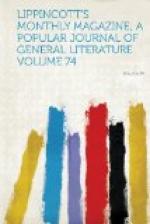Yet more expressive was the medley upon the covered platforms for the reception of freight. Eleven of these, each one hundred and sixty by twenty-four feet, admitted of the unloading of fifty-five freight-cars at once. At this rate there was not left the least room for anxiety as to the ability of the Commission and its employes to dispose, so far as their responsibility was concerned, of everything presented for exhibition within a very few days. The movements of the custom-house officials, and the arrangements of goods after the passing of that ordeal, were less rapid, and there seemed some ground for anxiety when it was found that in the last days of March scarce a tenth of the catalogued exhibits were on the ground, and for the closing ten days of the period fixed for the receipt of goods an average of one car-load per minute of the working hours was the calculated draft on the resources of the unloading sheds. Home exhibitors, by reason of the very completeness of their facilities of transport, were the most dilatory. The United States held back until her guests were served, confident in the abundant efficiency of the preparations made for bringing the entertainers to their side. Better thus than that foreigners should have been behind time.
When the gates of the enclosure were at last shut upon the steam-horse, a broader and more congenial field of duty opened before him. From the role of dray-horse he passed to that of courser. Marvels from the ends of the earth he had, with many a pant and heave, forward pull and backward push, brought together and dumped in their allotted places. Now it became his task to bear the fiery cross over hill and dale and gather the clans, men, women and children. The London exhibition of 1851 had 6,170,000 visitors, and that of 1862 had 6,211,103. Paris in 1855 had 4,533,464, and in 1867, 10,200,000. Vienna’s exhibition drew 7,254,867. The attendance at London on either occasion was barely double the number of her population. So it was with Paris at her first display, though she did much better subsequently. Vienna’s was the greatest success of all, according to this test. The least of all, if we may take it into the list, was that of New York in 1853. Her people numbered about the same with the visitors to her Crystal Palace—600,000. Philadelphia’s calculations went far beyond any of these figures, and she laid her plans accordingly.
Some trainbands from Northern and Southern cities might give their patriotic furor the bizarre form of a march across country, but the millions, if they came at all, must come by rail, and the problem was to multiply the facilities far beyond any previous experience, while reconciling the maximum of safety, comfort and speed with a reduction of fares. The arrangements are still to be tested, and are no doubt open to modification. On one point, however, and this an essential one, we apprehend no grounds of complaint. There will be no crowding.




